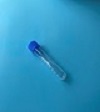Atypical Hemolytic Uremic Syndrome complement panel, serum and plasma
Atypical Hemolytic Uremic Syndrome complement panel, serum and plasma-994
HUS
- Detecting deficiencies in the alternative pathway that can cause atypical-hemolytic uremic syndrome, dense deposit disease, and C3 glomerulonephritis
- A second-order test that aids in the differential diagnosis of thrombotic microangiopathies
- Fasting preferred
- Do not collect specimens for at least 48 hours following plasma exchange.
- Immediatley following collection, mix sample by gentle inversion 3 - 4 times to prevent clotting
- Place tube on wet ice immediately after specimen collection
Plasma:
- Spin at 4◦ C in a refrigerated centrifuge
- Transfer plasma to two (2) Screw cap transfer vial/tubes (Mayo T914), each containing 0.75 mL labelled as EDTA plasma
- Freeze within 30 minutes
Serum:
- Allow serum sample to clot while on wet ice
- Spin at 4◦ C in a refrigerated centrifuge
- Transfer serum into three (3) Screw cap transfer vial/tubes (Mayo T914), each containing 0.5 mL labelled as serum
- Freeze within 30 minutes
NOTE: If a refrigerated centrifuge is not available, it is acceptable to use a room temperature centrifuge, provided the sample is kept on ice before centrifugation, and frozen immediately afterward
Five (5) Screw cap transfer vial/tube (Mayo T914) (3) labelled as serum and (2) labelled as EDTA plasma
Frozen (strict) - 14 days
Gross lipemia
C3HUS, C4HUS, FBCA, FHCA, C5AG2: Nephelometry
COM3: Automated Liposome Lysis Assay
AH503, C4D, CBB, SC5B9: Enzyme-Linked Immunosorbent Assay (ELISA)
An interpretive report will be included
Factor B complement Ag: 15.2-42.3 mg/dL
SC5b-9 complement: ≤250 ng/mL
Factor H complement Ag: 18.5-40.8 mg/dL
CBb complement activation fragment: ≤1.6 μg/mL
Complement C4: 14-40 mg/dL
Complement C3: 75-175 mg/dL
Complement, alternate pathway (AH50), functional: ≥46% normal
Complement, total: 30-75 U/mL
Reference values have not been established for patients who are <16 years of age.
86161
86162




